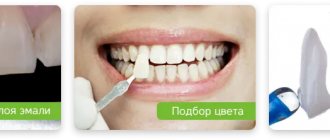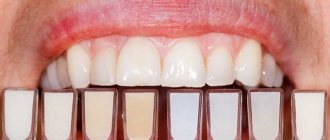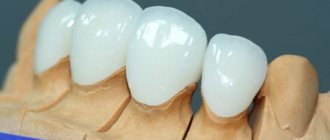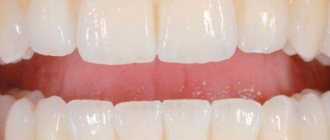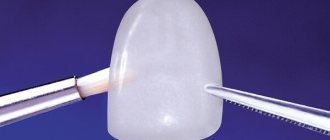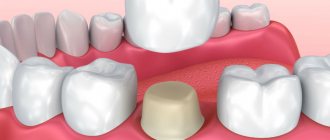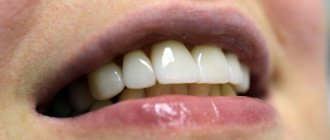Naturally perfectly smooth and dazzlingly white teeth are a rare gift. Moreover, the development of various oral diseases, bad habits and injuries can lead to a loss of aesthetic appeal of teeth at any time in a person’s life. And here modern dentistry and its achievements can come to the rescue: in this branch of medicine, various methods for correcting various dental imperfections have been developed and successfully used.
In addition to modern teeth whitening, one of these techniques is the installation of ceramic veneers. These thin plates can restore an attractive appearance to teeth with different types of defects: chips, cracks, pigment spots.
ADVANTAGES OF CERAMIC VENEERS
Ceramic (orthopedic) veneers are recognized as the best way to solve aesthetic problems in modern dentistry. The linings not only have solid strength and durability indicators, they are incredibly thin (the thickness of the plate does not exceed 0.5 millimeters). Ceramic veneers blend perfectly with the natural shade of tooth enamel.
The structures are produced in specialized dental laboratories and various materials are used for their manufacture, which we will tell you about below.
Preparatory process
1. Hygienic teeth cleaning, plaque removal.
2. Grind down a thin layer of enamel, from 0.5 to 0.7 mm.
3. A harmonious shade is selected.
4. The remaining enamel is coated with a special acid.
5. An impression is made.
6. The tooth plate is carefully polished and onlays are inserted.
A thin layer of enamel is ground off in order to achieve the most harmonious and natural look. They also grind it in order to insert and firmly strengthen the plate.
CERAMIC VENEERS FOR TEETH - INDICATIONS
Traditionally, ceramic veneers are placed on the front teeth, which are clearly visible to others when you smile. The material used to make the structures makes it possible to successfully use onlays even on second premolars and quickly solve the problem of noticeable and pronounced defects of dental surfaces.
Ceramic microprostheses can be installed both on absolutely healthy teeth and on the surface of teeth previously treated for caries or pulpitis. In terms of color, the overlays are matched tone to tone with the shade of the patient’s natural enamel. Ceramic veneers are used to successfully solve the following problems:
- Noticeable irregularities on the tooth surface;
- Darkening of the enamel caused by caries or other pathologies;
- The presence of chips and cracks in the enamel coating of the teeth;
- Significant interdental spaces;
- Severe demineralization of the enamel layer;
- Slight curvature of teeth;
- Change in color of previously installed fillings.
Ceramic veneers allow you to restore the natural attractiveness of your smile in a short time - sometimes even in one day.
Ceramic veneers
from 15400 rub. More about prices
We have been working since 1994
we are one of the first to open private dentistry in Moscow
Best materials
only new and modern equipment for dental treatment
Free
consultation with a dentist
Payment options
- cash
- plastic cards
- cashless payments
Doctors' experience
- with great experience
- graduated
- conference participants
When is the best time to get crowns?
When comparing indications for installing a ceramic crown or veneers, you need to focus on the condition of the tooth itself. The purpose of the prosthesis is to restore the function of the tooth, and not just to correct aesthetic defects.
The crowns are dome-shaped and are attached after preliminary grinding of the restored unit. Indications for prosthetics include:
- severe destruction of the coronal part;
- abnormal structure and rapid abrasion of enamel;
- unnatural position or disproportionate size of the tooth;
- loss of functionality;
- restoration in the presence of a large filling, chip or crack;
- destruction of installed orthopedic structures;
- the need for prosthetics of adjacent missing teeth.
Crowns are made from durable materials, some of which have their own leaders.
Materials for making crowns
Unlike veneers, metal-ceramics are a popular composition for prosthetics. Inexpensive, practical, but not without its drawbacks. Among the negative aspects are the translucency of the metal crown, discoloration of the gums, and possible allergic reactions. The list of disadvantages explains why dentists recommend other materials for making crowns - slightly more expensive, but incomparably better in quality and durability.
The leader among Moscow doctors is zirconium dioxide. It is a lightweight, rigid and bending-resistant material, ideal for dental prosthetics. Among its advantages:
- Biocompatibility.
- High mechanical stability.
- Durability.
- Light transmission is close to that of enamel.
- Resistant to staining by foods and drinks.
Crowns made of zirconium dioxide require minimal grinding of the tooth during installation, do not change the color of the mucous membrane at the point of contact, and completely merge with other units in color and texture.
PORCELAIN VENEERS
Porcelain is one of the best materials for the production of ceramic veneers, since structures made from it will have the following qualities:
- Resistance of the original color shade;
- High strength indicators;
- Transparency similar to natural tooth enamel.
Porcelain veneers are visually indistinguishable from normal healthy teeth.
Porcelain structures can be made using two different technologies. The first production technique involves layer-by-layer application of porcelain mass and its subsequent firing. According to the second technology, plates are produced by casting into a mold and subsequent pressing, which makes it possible to obtain a super-strong and abrasion-resistant structure.
ZIRCONIUM DIOXIDE VENEERS
Zirconium alloy veneers are produced under high temperature, and the process itself consists of several stages:
1. Initially, a frame is made from zirconium using a special (CAD/CAM) technology. This method involves the production of structures using fully automated machines, which ensures maximum accuracy of all dimensions.
2. Porcelain paste is applied to the finished model.
Zirconium veneers are extremely durable structures, especially in comparison with plates made from ordinary unpressed porcelain.
STEPS OF INSTALLING VENEERS ON TEETH
The process of installing veneers may seem simple only at first glance. In order to place a microprosthesis on the dental surface with high quality, the orthodontist requires professionalism, attentiveness, and specific knowledge and experience.
Ceramic dentures are made in about a week. During this period, the specialist carries out a number of preparatory works:
1. An impression is taken of the patient’s teeth. The procedure uses a special paste that allows you to take a fingerprint as accurately as possible.
2. Based on the frozen cast, a plaster model is made in the laboratory.
3. Veneers are produced using the finished model.
Immediately before installing ceramic veneers, a thin layer of natural enamel coating is removed from the patient’s tooth surface. This is necessary to obtain the area in which the veneer will be fixed.
The ceramic structure is fixed to the tooth surface with a special cement-based composition, which hardens under the influence of a special lamp. After fixing the veneer, the doctor aligns its contours to the level of the tooth, checks the strength of the structure, and finds out whether the microprosthesis prevents the patient from speaking, eating, or affecting the correct bite.
Diagnostics
The fixation of ceramic plates is carried out in three stages: preparation for the installation of veneers, production of the structure and fixation on the teeth.
Correctly performed diagnostics determines how long the orthopedic structure will serve the patient. In addition to the condition of the teeth, it is important to identify possible hidden pathologies in the bone and soft tissues of the jaw. And also carefully study the anatomical structure of the teeth being restored.
At EspaDent clinics, specialists conduct radiographic examinations for more accurate diagnosis. In complex cases, a modern 3D tomograph is used, which creates three-dimensional, layer-by-layer images of both jaws. During a consultation in our clinics, the doctor will offer the best options for microprostheses and immediately indicate the cost of the procedure.
CARE OF CERAMIC VENEERS
In order for installed veneers to last a long time, you need to know and follow all the rules for caring for ceramic microprostheses. The structures themselves will not change color and transparency even under the influence of aggressive external factors, however, under a number of circumstances, the cement fixing composition may begin to crumble. If you notice a similar phenomenon in yourself after the procedure, do not delay visiting the doctor!
After installing veneers, it is not recommended to abuse food and drinks that can stain the tooth surface. It is imperative to follow the rules of dental and oral hygiene: regularly clean the tooth surface from plaque using toothpaste, rinses and dental floss.
Lifetime
Depending on the type of structure, the service life is determined. For example, plates that overlap the cutting edge, according to research results, turned out to be a more reliable product.
Overlays made of pressed ceramics are considered to be the most durable. The material is able to retain its original properties for up to 12-15 years, without deteriorating in appearance. Here, it is not the ceramic veneer that wears out to a greater extent, but the cement on which it is attached.
Zirconium plates are not far behind in reliability. Their lifespan is at least 10-15 years. The most expensive lumineers, with proper care, will delight their owner for up to 20 years.
Wear resistance is directly affected by the quality of production and installation of the plates. Porcelain veneers that do not fit tightly to the surface of the tooth can crack or even fall out. And bacteria will accumulate in the space between the tooth and the plate, which will lead to the appearance of carious cavities. Therefore, it is important to carefully choose a clinic and a doctor for prosthetics and dental treatment procedures.
ADVANTAGES OF CERAMIC VENEERS
Ceramic veneers compare favorably with other types of dental structures in the following advantages:
- The shortest installation time. The plates are installed for the patient in just two or three visits to the orthodontist;
- Ideal combination with natural tooth color;
- Maximum tightness of contact with the tooth surface;
- Color fastness regardless of negative external factors;
- Aesthetic, natural look;
- Durability.
Do you want to become the owner of an attractive and blindingly white smile? Contact us for the installation of ceramic veneers at our dentistry in Moscow - Vanstom!
Content:
- Main differences
- Types of veneers
- Dental crowns
- Veneers or crowns - how to make a choice 4.1. When is it better to install veneers 4.2. When you can't do without crowns
- Can veneers be glued to crowns?
The wording of the question “Veneers or crowns?” not entirely true. These designs are used in different clinical situations, although they can conditionally be classified as one area in dentistry. Meanwhile, in medical practice, sometimes there are cases when the patient needs to choose what to install - a thin overlay or a full-fledged prosthesis that replaces the entire unit.
CONTRAINDICATIONS. WHO IS VENEERS SUITABLE FOR?
Like any other medical procedure, the installation of ceramic veneers has contraindications. It is worth refusing to use microprostheses:
1. In the presence of caries and other untreated dental diseases. This restriction is temporary.
2. In case of significant destruction of tooth dentin and large fillings installed.
3. In the presence of bruxism.
Before starting treatment, the orthodontist must conduct a thorough examination of the patient to exclude the presence of the listed contraindications.
Manufacturers
To protect yourself from low-quality prosthetics, check with the clinic about what materials are used in the procedure. Mainly large companies specialize in the production of ceramic veneers. There aren't many of them.
The most famous company Nobel Biocare is a leader in implantology and prosthetics. It was this manufacturer that developed the popular protocols for implantation procedures All-on-4, All-on-6, Trefoil, etc. In the case of installing veneers, the company specializes in the production of zirconium plates.
The list includes German and Japanese companies that produce their products under the brands Katana, Prettau and BruxZir Anterior. The leader in the production of pressed and solid ceramics is Ivoclar Vivadent, which specializes in Emax technology.
Many years of experience, modern materials and strict quality control allow these companies to occupy a strong position in the dental materials market.
CERAMIC VENEERS PRICE FOR 1 TOOTH IN MOSCOW
Correcting aesthetic defects of dental surfaces using ceramic veneers cannot be called a budget procedure. The high price of structures is due to the complexity of their production, increased requirements for aesthetics and strength.
But the cost of installing ceramic veneers is fully compensated by their strength, reliability, and ability to ideally mask noticeable and pronounced dental defects.
Detailed advice on installing ceramic veneers and the cost of the service can be obtained from our dentistry specialists in Moscow - Vanstom!
How to choose materials?
When it comes to the restoration of anterior teeth, in addition to the functional characteristics of the structures, the aesthetic side of the issue must be taken into account. Aesthetics is directly related to the quality of the material, and it is believed that veneers are better than crowns in this regard. This is partly true, but with the right selection of material and design, crowns will also look natural and beautiful. There is only one problem when installing crowns: choosing the right shade of dentures in accordance with the adjacent teeth. The task becomes easier if you replace the entire set of teeth at once, because the structure is made of one material. Metal-ceramic crowns. They are very popular due to the price-quality ratio, but in terms of aesthetics they are far from perfect. Characteristics of metal-ceramic crowns.
- There is a cosmetic effect, but the difference next to natural teeth most often remains noticeable.
- Reliable, durable. They can withstand serious loads; chipping is possible only under very strong mechanical stress.
- Service life up to 10 years.
- Depulpation is necessary and the dental tissue is subjected to significant grinding.
- Quite a reasonable price.
There are also crowns made of metal-free ceramics: zirconium and porcelain. They are inferior to metal-ceramics in terms of strength, but have higher aesthetic values. If a person does not put heavy loads on ceramic prosthetic teeth, they will last about 10 years.

